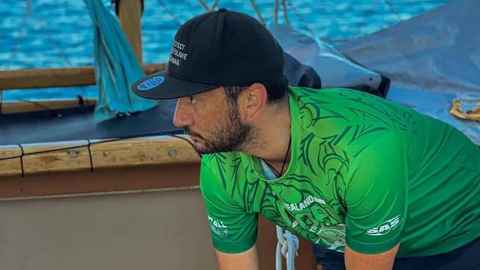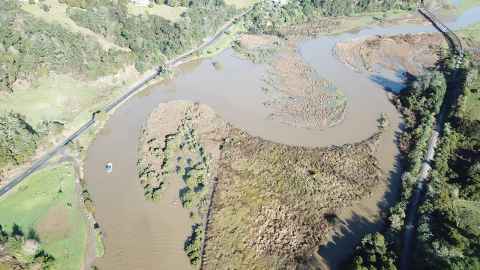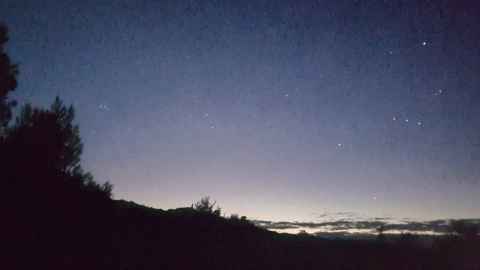How maramataka can guide kaitiakitanga of awa and moana
19 August 2022
Te Kahuratai Painting (Ngāti Manu, Te Popoto, Ngāpuhi) is exploring how maramataka can guide Ngāti Manu kaitiakitanga of awa and moana.

For his Master of Marine Conservation project, Te Kahuratai Painting explored the interconnection between Ngāti Manu kaitiakitanga and maramataka, and how research practice in marine conservation can be guided by maramataka and grounded in whakapapa.
Maramataka is the Māori lunar-stellar-ecological calendar that uses the phases of the moon, the rising of stars in the morning and the timing of ecological phenomena to understand and relate to the environment around us in Aotearoa New Zealand. The revitalisation of maramataka is thriving in Te Ao Māori at the moment, led by maramataka experts like Rereata Makiha, Rangi Mātāmua and Rikki Solomon.
Te Kahuratai was supervised by Dr Dan Hikuroa and Dr Tara McAllister, both principal investigators at Te Pūnaha Matatini, and his mahi was funded by a masters scholarship from Te Pūnaha Matatini.
“It was really me exploring two things,” says Te Kahuratai, “my love of maramataka, and of my hapū Ngāti Manu.”
“Our hapū, being in the valley, is well connected to our forests and our river, but the moana was a gap for me, so I thought I would study marine conservation to fill that gap to help to reconstruct maramataka with our hapū.”

The maramataka system of knowledge includes tātai arorangi Māori astronomy, knowledge of the lunar phases, knowledge of the tides and weather patterns, as well as the timing of the flowering of different trees or the migration of different birds, or the running of fish up and down a river. “That can lead to a very specific and quite deep knowledge of our environment,” says Te Kahuratai.
“Kaitiakitanga is often just seen as conservation by Māori, but our understanding of kaitiakitanga is so much deeper than that.”
The ongoing Covid-19 pandemic prevented Te Kahuratai from holding a planned week-long wānanga at his marae, talking about and looking at stars, learning about the lunar-stellar-ecological calendar, and watching specific marine phenomena.
“What happened instead was a really theoretical exploration of how other people have recreated their own maramataka, because there’s more than 500 across the country,” says Te Kahuratai. “It’s really specific – a coastal maramataka versus an inland maramataka would be different, from one coast to the other could be different, one side of the mountain to the other side of the mountain could be different.”
In his thesis, Te Kahuratai linked existing maramataka for the Ngāti Manu rohe of Karetu and Taumarere in the Bay of Islands with the teachings of maramataka experts. He conceptualised pūtaiao as Kaupapa Māori science, developed a framework grounded in kaitiakitanga and maramataka for marine conservation, and asked how we can use knowledge like maramataka to change that way that Kaupapa Māori research is conducted.
“If you’re researching it, you should be practicing it,” says Te Kahuratai.
Tara says that “it was a privilege to work with Te Kahuratai on his master’s thesis. In Te Ao Māori we often talk about tuākana/teina relations, and in this case Te Kahuratai was the tuākana and I was the teina, and I learnt so much from engaging with his work.”
Te Kahuratai was gifted maramataka from Taumarere by Rereata Makiha.
“I worked with three different manuscripts,” explains Te Kahuratai. “One was written in the early 1900s. One was based on an early manuscript but was reprinted for schools back in the 1980s, and the third was a really old one from before the Māori written system was formalised, and it was based on symbols.”
“The level of detail in them is crazy. They name the specific nights that you should expect the bulk of īnanga whitebait to run, specific nights for planting vegetables that grow in the ground, specific nights for planting vegetables that grow above the ground, specific nights for planting vegetables that like a lot of water, or good times to use particular methods in specific places to do certain types of fishing.”

Te Kahuratai is planning to explore these maramataka as a PhD project, to see if the changing climate affects the guidance from ngā wā ō mua many decades ago, and investigate how they could be updated for the more unpredictable contemporary environmental conditions caused by a warming planet.
Dan is excited about this research because of “the scope, the privileging of deep knowledge of a specific place, tested through time, and its application in contemporary times, and how it can inform conservation practices.”
Te Kahuratai’s thesis concludes with a framework that will guide this PhD research, based on the whakataukī “Tuia ki te rangi, tuia ki te whenua, tuia ki te moana, tuia ki te here tangata, ka rongo te po, ka rongo te ao,” which means: “weave towards the sky, towards the land, towards the waters, and weave to the binding thread of people, and then you will come to understand the divisions of night and day”.
For Tara, “Te Kahuratai’s thesis is a koha, especially for Ngāti Manu, filled with insight and provocations to rethink the way in which we do our research.”